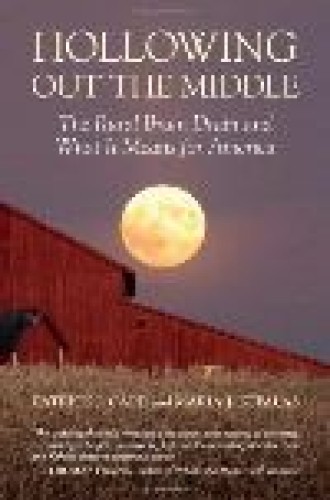Hollowing Out the Middle: The RuralBrainDrain and What It Means forAmerica
In the wake of the farm crisis of the 1980s, two New Jersey sociologists, Deborah and Frank Popper, suggested that the middle of the United States (between the spine of the Continental Divide and the 98th meridian—from the middle of North Dakota to the middle of Texas) should be designated a “Buffalo Commons.” This suggestion was met with bitter antagonism from the good people who lived in the communities they proposed returning to the buffalo.
Approaching Hollowing Out the Middle, I feared a similar insensitivity to the values of the heartland. But I was wrong. The team of Patrick Carr and Maria Kefalas offer Midwestern congregations and communities a sympathetic, if realistic and disturbing, analysis of the future.
Two things stand out in their analysis. First, they focus on the life trajectories of rural youth, and second, Carr and Kefalas lived in a 2,000-person town in Iowa for several years. Their focus on youth works well as an entry into current town and country dynamics. The nice surprise is that they focus as much on the Stayers and Returners as they do on the Achievers and Seekers.
Too often social scientific and practical ministry studies concentrate on the youth who leave town and country life rather than those who stay to lead and shape their towns. This gap in the research may obscure a tendency for rural churches to neglect, if not ignore, those who are not among the first rank and focus instead on the “most promising” intellectuals, athletes and so on. Such an elitist focus bodes poorly for community and congregational leadership. This book strongly recommends that rural communities concentrate at least as much energy and effort on the people who stay in or return to the community as they do on the elite who leave.
“Ellis,” the Iowa town where the authors lived, is similar to many others. Carr and Kefalas use interviews and observations to describe the many assets of Ellis, as well as the drawbacks of living there. Rather than being prejudiced against small towns and small churches, Carr and Kefalas appear to like and, more important, to understand the attractions of living there.
What the authors fail to do is to raise questions about what this analysis implies for congregational leadership and community ministry. Are the small churches of our denominations being hollowed out by analogous dynamics? There is a virulent classism at work in congregations as well as communities. The Achievers seem to come overwhelmingly from the upper class or at least from comfortable professional homes. The children of these families do not have to work from September to May and are free to concentrate on studies, athletics and extracurricular activities.
Families and whole towns encourage their Achievers to leave “Ellis” and “make them proud.” Schools tend to be guilty of overlooking the value of the local as well. Are churches doing a similar thing by not attending to the local assets, knowledge and forms of leadership that could allow town and country churches to thrive?
Though it may seem romantic or idealistic, I believe that there is much to be said about the affinity of Christian values with the neighborliness, community and attention to the well-being of youth and family that still to some degree characterize towns like “Ellis” in the Midwest and elsewhere in rural America. However, there is a subtle and growing capitulation to the values of affluence—such as individual achievement, consumption and financial success—in rural America. My hope is that these values will not overwhelm those that are perhaps more prosaic. Many town and country congregations fail to claim or build on their assets—assets that may offset the appeal of higher incomes or the fast life.
In a way that is reminiscent of Cynthia M. Duncan’s Worlds Apart: Why Poverty Persists in Rural America, Carr and Kefalas raise questions for the church in a narrative sociology that draws us into the lives and values of rural communities and congregations. Never pushy or polemical, the authors suggest what the future may be like if we continue to travel down the road we have taken, and they hint at better directions as well.





